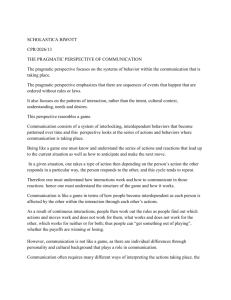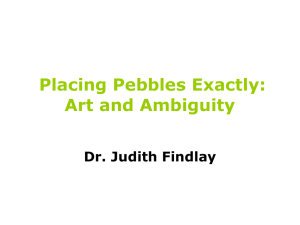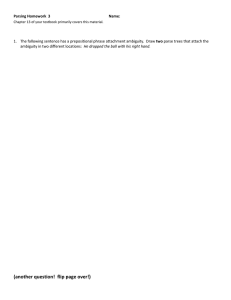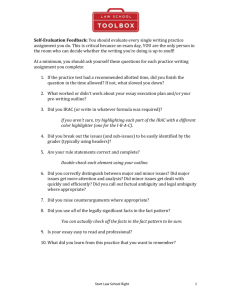Definite descriptions: Semantic or pragmatic polysemy?* Beata Zacharska
advertisement
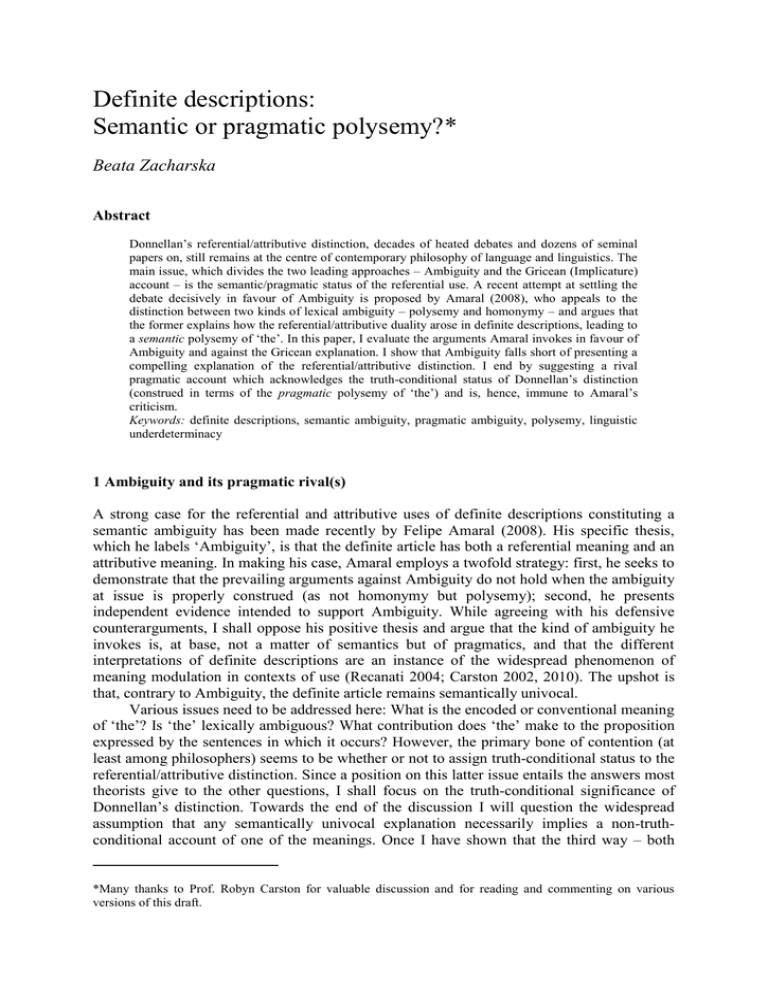
Definite descriptions: Semantic or pragmatic polysemy?* Beata Zacharska Abstract Donnellan‘s referential/attributive distinction, decades of heated debates and dozens of seminal papers on, still remains at the centre of contemporary philosophy of language and linguistics. The main issue, which divides the two leading approaches – Ambiguity and the Gricean (Implicature) account – is the semantic/pragmatic status of the referential use. A recent attempt at settling the debate decisively in favour of Ambiguity is proposed by Amaral (2008), who appeals to the distinction between two kinds of lexical ambiguity – polysemy and homonymy – and argues that the former explains how the referential/attributive duality arose in definite descriptions, leading to a semantic polysemy of ‗the‘. In this paper, I evaluate the arguments Amaral invokes in favour of Ambiguity and against the Gricean explanation. I show that Ambiguity falls short of presenting a compelling explanation of the referential/attributive distinction. I end by suggesting a rival pragmatic account which acknowledges the truth-conditional status of Donnellan‘s distinction (construed in terms of the pragmatic polysemy of ‗the‘) and is, hence, immune to Amaral‘s criticism. Keywords: definite descriptions, semantic ambiguity, pragmatic ambiguity, polysemy, linguistic underdeterminacy 1 Ambiguity and its pragmatic rival(s) A strong case for the referential and attributive uses of definite descriptions constituting a semantic ambiguity has been made recently by Felipe Amaral (2008). His specific thesis, which he labels ‗Ambiguity‘, is that the definite article has both a referential meaning and an attributive meaning. In making his case, Amaral employs a twofold strategy: first, he seeks to demonstrate that the prevailing arguments against Ambiguity do not hold when the ambiguity at issue is properly construed (as not homonymy but polysemy); second, he presents independent evidence intended to support Ambiguity. While agreeing with his defensive counterarguments, I shall oppose his positive thesis and argue that the kind of ambiguity he invokes is, at base, not a matter of semantics but of pragmatics, and that the different interpretations of definite descriptions are an instance of the widespread phenomenon of meaning modulation in contexts of use (Recanati 2004; Carston 2002, 2010). The upshot is that, contrary to Ambiguity, the definite article remains semantically univocal. Various issues need to be addressed here: What is the encoded or conventional meaning of ‗the‘? Is ‗the‘ lexically ambiguous? What contribution does ‗the‘ make to the proposition expressed by the sentences in which it occurs? However, the primary bone of contention (at least among philosophers) seems to be whether or not to assign truth-conditional status to the referential/attributive distinction. Since a position on this latter issue entails the answers most theorists give to the other questions, I shall focus on the truth-conditional significance of Donnellan‘s distinction. Towards the end of the discussion I will question the widespread assumption that any semantically univocal explanation necessarily implies a non-truthconditional account of one of the meanings. Once I have shown that the third way – both *Many thanks to Prof. Robyn Carston for valuable discussion and for reading and commenting on various versions of this draft. UCLWPL 2010.01 57 pragmatic and truth-conditional – is not only feasible, but also preferable, the onus to prove that their view is better will be back with the Ambiguity theorists. For now, though, let‘s assume, as does Amaral, that the debate concerns two (not three) opposing camps, and that the dividing line separates those who assume that the distinction is truth-conditionally significant (i.e. it gives rise to two distinct propositions expressed) from those who maintain that descriptions have only the quantificational attributive semantics with the referential meaning manifesting itself at the level of what is meant (implicature). There is little, if any, overlap between the two sides (let‘s call them ‗Ambiguity‘ and ‗pragmatic‘ 1), and the commitment to either camp on one issue normally entails the tacit acceptance of a series of other theoretical assumptions. The reasoning behind this status quo, which has much to do with a certain view of the role of pragmatics in utterance comprehension, is as follows: if a given phenomenon is semantically significant in two distinct ways, it must, ex hypothesi, derive from an underlying lexical ambiguity. So, those who believe that the referential/attributive contrast reflects a truth-conditional difference, must also endorse the view that ‗the‘ is lexically ambiguous (Devitt 2007; Amaral 2008). And vice versa: the adherents of the pragmatic camp, who postulate a univocal semantic analysis for all instances of ‗the F‘, must, ipso facto, explain the referential use in terms of implicated speaker meaning (Grice 1969; Kripke 1977; Neale 1990; Bach 2004). 2 Against the Gricean account (Literalness of the referential use) The arguments against the ambiguity of definite descriptions that Amaral addresses can be divided into two groups which, I claim, are not of equal significance. First, there is the socalled Gricean argument which appeals to a general principle of parsimony, in the form of Modified Occam‘s Razor. This law of theoretical economy naturally favours semantically univocal accounts over Ambiguity whenever there is an adequate pragmatic account of how the second meaning arises. Second, we have two independent, yet closely related, arguments by Kripke (1977) and Bach (2004) who question the very essence of the Ambiguity theory – the existence of lexical ambiguity in the semantics of ‗the‘. While the Gricean argument does not challenge the legitimacy of Ambiguity, but, rather, offers an alternative (pragmatic) explanation which is to be preferred on purely methodological grounds, the second argument carries an altogether different charge. For, if it can be shown that there is independent evidence against Ambiguity, we need not invoke a parsimony principle, or for that matter any other principle, to help us decide between the semantic and the pragmatic accounts. Indeed, the two arguments differ not only in their force but also in the type of questions they raise and, consequently, the answers they can receive. Let‘s look at them in turn. Amaral questions the basic tenet of the Gricean explanation, i.e. that there is a substantial difference in status between referential and attributive uses of descriptions, arguing that there is nothing non-literal about the referential use of descriptions. First, he points out the regularity and frequency of the referential use in communication (see also Devitt‘s (2004) Argument from Convention), and, second, the similarity of referentially used definite descriptions to complex demonstratives, whose canonical use is referential. The final piece of evidence against the Gricean account is based on the occurrence of ‗incomplete‘ descriptions (e.g. ‗the table‘), which are felicitously used to convey a thought about a particular object even when the speaker himself, through ‗ignorance or error‘ (see Devitt 2004: 301-303), cannot provide completions for them (hence, arguably, no general proposition can be expressed). The main question, then, that the Gricean argument raises is whether the referential use is ‗literal‘ (i.e. 1 If not otherwise stated, ‗pragmatic‘ will mean ‗non-truth-conditional‘. UCLWPL 2010.01 58 is part of ‗what is said‘, rather than merely ‗what is meant‘), and the answer it receives, in accordance with most people‘s intuitions2, is ‗yes‘: the speaker who uses a description referentially intends to express a singular proposition. No revelation here, but the attack on the implicature account of referentially used descriptions is not the central point of Amaral‘s critique. 3 Against Kripke’s and Bach’s objections (Homonymy vs Polysemy) The discussion really takes off when Amaral turns to the arguments invoking cross-linguistic evidence. While Bach raises concerns specifically about the alleged lexical ambiguity of ‗the‘, and Kripke‘s considerations bear on the nature of lexical ambiguity in general, in the end, their arguments rest on a similar assumption and so I will treat them together. What is novel about Amaral‘s approach is the way he uses the cross-linguistic evidence to argue in favour of Ambiguity. But before we see the solution he proposes, let us, again, look first at the questions raised. For Bach, an explanation of the referential/attributive distinction in terms of lexical ambiguity overlooks the cross-linguistic regularity of Donnellan‘s distinction and, thus, commits us to accepting that a particular lexical ambiguity can recur as single lexical form in numerous languages, which he considers highly dubious. The question Bach‘s worry raises is the following: do we (should we) expect lexical ambiguity to carry over from one language to the next? According to Kripke (1977), we don‘t and shouldn‘t: in order to count as a genuine instance of lexical ambiguity, the alleged home language ambiguity needs to be ‗removed‘ in other languages. And since there is no conclusive evidence that there exists a language with two distinct words corresponding to referential and attributive uses of definite descriptions in English, the lexical semantic distinction should be abandoned and give way to a unitary account (1977: 19). Amaral, on the other hand, holds a far less authoritarian view on this question. Lexical ambiguity may or may not be removed, is his answer, for it depends on the kind of phenomenon we are dealing with. If the ambiguity is of the homonymous type (i.e. the result of coincidental homography/homophony of two etymologically distinct words), then we do not expect it to display any interesting cross-linguistic regularity. Take the English word ‗jumper‘– it is highly unlikely that any other language would associate the same group of very diverse meanings (a knitted garment, a person or animal that jumps, a heavy chisel-ended iron bar for drilling blast holes3) with a single lexical form. However, the story is very different when it comes to polysemy, whereby a single lexeme may be associated with two or more etymologically related senses: think, for instance, of the multiple meanings of ‗jacket‘, describing different kinds of outer coverings: a piece of clothing, a potato skin, a cover of a book, etc. If we agree with Amaral (who follows Ravin and Leacock 2000) that polysemy ‗is the product of conceptual associations made by speakers‘ (2008: 290), which are, moreover, ‗independent of the particular languages speakers in fact speak‘ (ibid: 291), then such cross-linguistic regularities are not only not surprising but to be expected. It should be clear now that Bach‘s objection goes through only insofar as the various uses or senses of ‗the‘ are treated as homonyms. That this line of reasoning is futile is evidenced by most diachronic studies which suggest that as far as the evolution of the definite article is concerned, we are invariably dealing with a single linguistic ancestor – in most cases a deictic term (see Lyons 1999; Faingold 2003). Moreover, there is such an intimate 2 See, e.g., Recanati‘s Availability Principle (2004:20). 3 Rothwell, D. 2007. Dictionary of Homonyms. Wordsworth Editions. UCLWPL 2010.01 59 relation between referential and attributive uses of ‗the‘, that, as Amaral argues, the one could easily give rise to the other in a process of polysemous meaning extension. Suppose that the definite description form started out as semantically attributive (Russellian), then on occasions of use when the shared context is such that it applies uniquely to an object, the speaker could use it to identify that object (perhaps when the object was already perceptually available or in some other way highly accessible) and thereby express a singular proposition with the object as a constituent. Conversely, suppose the description began life as inherently referential, it could then be used (somewhat loosely), in the contextual absence of a plausible referent, to express at least a general proposition to the effect that there is some unique F which has such and such property. 4 Problem I: Proliferation of Senses We have now seen the main line of argument Amaral adopts in his defense of Ambiguity, and it seems that a well-motivated polysemy account could indeed offer a viable alternative to a non-truth-conditional pragmatic explanation. For one thing, Amaral‘s approach offers a prima facie compelling explanation of how a single core meaning could gradually extend its use to cover a related sense. The assumed greater communicative efficiency that such a meaning duality enables could, in turn, lead to its widespread use and, ultimately, to the establishment of a second semantic convention for the one form. The fact that the derivation could, in principle, apply either way depending on context (referential sense giving rise to an attributive meaning, or vice versa), highlights the pragmatic nature of the contrast in question (and polysemy in general). What Amaral does not explain is how the intended interpretation is selected, i.e. what principles determine which of the many possible associations gives rise to a new sense (hence to polysemy). Clearly, some pragmatic constraints must come into play (e.g. considerations of relevance (Sperber & Wilson 1986/1995) or accessibility (Recanati: 2004)), and even though Amaral does not make any explicit claim to this effect, his account appears to fit particularly well with Recanati‘s (2004) associative account of primary pragmatic processes, on which the latter says: In the model I have in mind, the literal meaning of the expression is accessed first and triggers the activation of associatively related representations. (...) All candidates, whether literal or derived, are processed in parallel and compete. When an interpretation which fits the broader context of discourse is found, it is selected (it undergoes semantic composition) and the other candidates are suppressed. (2004: 28) However, if a single sense lies at the root of the phenomenon, as Amaral seems to assume, and pragmatic mechanisms provide a viable and parsimonious explanation for the second sense, why does he think the polysemy of ‗the‘ is semantic (i.e. conventional, encoded)? A possible reason for taking this position comes from Devitt‘s Argument from Convention (2004, 2007), to which Amaral clearly alludes when he writes: (...) definite descriptions are regularly used referentially, and this shows that there is no prima facie reason to deny that referential uses are literal; actually, this usage regularity strongly suggests that referential uses are literal, just as literal as attributive uses; (2008: 288-89) But then, by parity of reason, Amaral should also claim that many instances of generalized conversational implicatures (e.g. scalars, such as the inference from ‗some‘ to ‗some but not UCLWPL 2010.01 60 all‘) and approximations (‗square‘, ‗flat‘ meaning ‗squarish‘, ‗flattish‘), which are regular (and frequent), are, in fact, also instances of conventional meanings, hence ‗some‘, ‗square‘, etc. are ambiguous (polysemous). Interestingly, Bach (2004: 227) acknowledges this regularity (‗pragmatic regularity‘, as he calls it) of the referential use and treats it as akin to generalized conversational implicatures. While Amaral would surely reject such an analysis on the grounds of the intuitive truth-conditional significance of the referential/attributive distinction (which an implicature explanation fails to account for), he still needs to explain what makes a semantic convention based on regularity of use applicable to referential uses of descriptions, but not to other instances of recurrent second meanings of words. This problem becomes all too obvious when we consider the meanings of words such as ‗run‘ (verb) or ‗light‘ (adjective), which, depending on the lexicographic source, have between 7 and 43 distinct, yet related, senses. It looks as if there is virtually no limit, barring lexicographers‘ imaginations, to the proliferation of senses, a clear reflection of the usagebased (hence pragmatic) nature of the phenomenon at issue. While ‗the F‘ is clearly less exuberant than ‗run‘ in terms of its possible senses, it does have, additional to the familiar referential/attributive duality, a variety of other uses: specific, generic, functional, appositive, predicative (see Barwise & Perry 1983; Rouchota 1994). The question is whether we really want to represent each of the various conceptually related senses lexically, making for complex disjunctive semantic representations which give no indication, let alone explanation, of the relatedness of senses. Thus, in order to make a case for the semantic ambiguity of a given phenomenon, one needs to show what advantage it has that would offset these obvious drawbacks. The only such advantage that Amaral‘s account appears to have is its compliance with the truth-conditional significance of Donnellan‘s contrast. But while this might have force against a pragmatic explanation which insists that pragmatics is confined to conversational implicature and so denies the referential/attributive distinction any semantic (truth-conditional) significance, it will have no impact on a pragmatic account which recognizes equal ‗literalness‘ (truth-conditionality) of the two uses, which seems, in fact, to have been Donnellan‘s own view of the distinction (which he labelled a ‗pragmatic ambiguity‘4 (1966: 297)). Why has Amaral (along with many other Ambiguity theorists) overlooked (or ignored) the possibility of coming up with a pragmatic and, at the same time, truth-conditional explanation of the phenomenon? The very same reason, whatever it is, seems to have led Devitt (2007: 16) to claim that his Ambiguity hypothesis ‗should be preferred to any pragmatic explanation‘. What grounds do these theorists have for such confidence in the inevitable superiority of their semantic accounts? 5 Problem II: the Division of Labour (Semantic/Pragmatic Interface) We are now returning to the mistaken, yet widespread assumption I alluded to at the beginning of the discussion. The uncovering of this fallacy will help us understand what 4 Compare Donnellan‘s notoriously vague use of the term ‗pragmatic ambiguity‘ with a more articulate take on it by Recanati: There is pragmatic ambiguity whenever a sentence which is not semantically (i.e. linguistically) ambiguous can nevertheless express different propositions in different contexts, owing to some primary pragmatic process involved in the contextual determination of what is said (1993: 261). As we shall see later, definite descriptions are indeed, as Donnellan predicted (yet was unable to conclusively argue for in the absence of the necessary pragmatic apparatus), a very likely candidate for pragmatically ambiguous terms. UCLWPL 2010.01 61 ambiguity theorists, such as Devitt and Amaral, take ‗pragmatic accounts‘ to amount to, and why they believe the latter do not stand a chance against Ambiguity. Once it is recognised that pragmatic mechanisms play a crucial role not only in retrieving implicatures, but also in grasping the truth-conditional content of the utterance, the Ambiguity theorists will be faced with a much more serious pragmatic challenge. Devitt (2007: 16) bases his claim for the superiority of Ambiguity over the Gricean hypothesis (and for that matter any other pragmatic account) on the following generalization: For, if we can show that a person who utters S with a definite used referentially, thus conveying somehow the singular proposition that q, does not also say a general proposition that p, then we have shown that (ii) [Ambiguity] should be preferred to (i) [the Gricean hypothesis]. Bearing in mind the argument from ‗incompleteness‘ which allegedly shows the impossibility of determining such a general proposition on many occasions5, it should be clear why Ambiguity theorists feel that they have such a strong case against pragmatic accounts. However, this victory proves illusory once we scrutinize the premiss upon which Devitt‘s generalization is based. For, in order for this line of reasoning to go through, we need to accept a further condition: pragmatically derived meaning must be equated with implicated meaning. In other words, pragmatic inferencing plays no role (barring disambiguation and reference assignment) in the retrieval of the proposition expressed, which is simply a matter of linguistic conventions. This assumption has been challenged by many pragmatic theorists (e.g., Carston 2002; Recanati 1993, 2004), who have pointed out the systematic gap between the linguistically encoded (or conventional) meaning of a sentence and the propositional content the speaker intends on a given occasion of use of that sentence. Hence, a single sentence, e.g. She‘s had enough. (1) While not lexically ambiguous, will, owing to the incompleteness of ‗enough‘ and the underdeterminacy of ‗had‘, give rise to different propositions in different contexts: (2) a. b. (uttered by a mother referring to the daughter whom the father is trying to feed) HANNAH HAS EATEN ENOUGH (uttered by a gym trainer) MARTA HAS DONE ENOUGH EXERCISE each of which, in turn, might communicate some further propositions (‗implicatures‘), often quite different from what is literally said: (3) a. b. DON‘T FORCE THE CHILD TO EAT MORE DON‘T MAKE HER TRAIN ANY MORE Bearing in meaning this triad of meaning (i.e. sentence meaning (1), ‗what is said‘ (2), ‗what is implicated‘ (3) (see Recanati 2004 for details), we might now try to measure the various 5 The argument from incompleteness appears not to be as strong as Devitt takes it to be, though. For, any occurrence of such an incomplete description might still give rise to a truth-evaluable (albeit obviously false) general proposition: e.g. that there is one and only one table and it is covered with books. UCLWPL 2010.01 62 accounts of Donnellan‘s distinction against it. While the implicature account ascribes the difference to the third level (hence referential use is external to ‗what is said‘), Ambiguity account locates the phenomenon of the referential/attributive distinction at the very core of the linguistic meaning of ‗the‘, so that the descriptive phrase and then the sentence it occurs in are, via semantic composition, also conventionally assigned two different meanings (hence, are semantically ambiguous). However, there is clearly a third way to go – namely, to treat the semantics of the definite article as akin to other words whose univocal conventional meaning may give rise to different contents (semantic values) in different contexts. This analysis would certainly involve an element of underdeterminacy in the lexical meaning of ‗the‘6 which would need to be resolved by pragmatic inferencing. However, even on the ambiguity account pragmatic mechanisms must select the contextually relevant meaning (referential or attributive) and assign a referent to the former, so they inevitably play a crucial part in the process of ascertaining the truth-conditional content. Hence, since linguistic underdeterminacy is utterly commonplace in language (perhaps even an essential feature of human languages in general), the conjunction ‗pragmatic and truth-conditional‘ turns out to be not a contradiction, but, on the contrary, a necessity. 6 Semantic or Pragmatic Polysemy? This finding marks a significant shift in the debate on definite descriptions. Until now, ambiguity theorists could feel relatively secure on their side of the dividing line: the pragmatic (non-truth conditional) opposition, convinced of the univocal lexical semantics of ‗the‘ yet limited by the standard assumption about the role of pragmatics, could not enter their territory but had to concede to an implicature hypothesis. However, with the alternative pragmatic and truth-conditional account at hand, Ambiguity faces a new kind of challenge. The situation is rendered even more complicated by the striking similarity between Amaral‘s Ambiguity approach and the new pragmatic contender. Not only do they share the conviction of the truth-conditional significance of Donnellan‘s contrast, but they also seem to converge on how the originally unambiguous term could gradually extend its use via general pragmatic mechanisms. It seems, therefore, that the centre of interest, up to now taken to be the truth-conditional significance of Donnellan‘s contrast, should be relocated to reflect the current state of affairs. For, the question now is not whether the referential use is just as ‗literal‘ as the attributive use, but, rather, whether the two uses amount to two distinct linguistic encodings or conventions (semantic ambiguity) or are, rather, two manifestations of a context-sensitive element of ‗what is said‘ (pragmatic ambiguity). Such pragmatic ambiguity accounts have already been put forward in the literature (see Recanati 1993; Powell 2010), and the solutions they offer, based on the assumption of the linguistic underdeterminacy of expressed content, appeal to general pragmatic mechanisms, which makes them a compelling alternative to the semantic ambiguity account. The onus to prove their analysis is preferable to the pragmatic (hence semantically univocal) account is now firmly back with the semantic ambiguity camp. 6 What the encoded meaning of ‗the‘ amounts to is a separate question. Is the meaning of ‗the‘ a kind of procedure (similar to that encoded by an indexical)? What about the conceptual content of ‗the F‘ – how does it interact with the meaning of ‗the‘? See Powell (2010) for a discussion. UCLWPL 2010.01 63 References Amaral, F. S. 2008. Definite descriptions are ambiguous. Analysis 68(4): 288-297. Bach, K. 2004. Descriptions: Points of Reference. In M. Reimer and A. Bezuidenhout (eds.), Definite Descriptions and Beyond. Oxford: Clarendon Press: 189–229. Barwise, K. J. & J. Perry. 1983. Situations and Attitudes. Cambridge: MIT Press. Carston, R. 2002. Thoughts and Utterances. Oxford: Blackwell. 2010. Explicit Communication and ‗Free‘ Pragmatic Enrichment. In B. Soria and E. Romero (eds.), Explicit Communication. Palgrave Macmillan. Devitt, M. 2004. The Case for Referential Descriptions. In M. Reimer and A. Bezuidenhout (eds.), Definite Descriptions and Beyond. Oxford: Clarendon Press: 280-305. 2007. Referential Descriptions and Conversational Implicatures. European Journal of Analytic Philosophy, Vol. 3, No. 2: 7-32. Donnellan, K. 1966. Reference and definite descriptions. The Philosophical Review 75: 281 – 304. Faingold, E. D. 2003. The Development of Grammar in Spanish and the Romance Languages. Palgrave Macmillan. Grice, H. P. 1969. Vacuous names. In D. Davidson and J. Hintikka (eds.), Words and Objections. Dordrecht: Reidel: 118-45. Kripke, S. 1977. Speaker‘s reference and semantic reference. In P. A. French, T. E. Uehling Jr., &. H. K. Wettstein, (eds.), Contemporary Perspectives in the Philosophy of Language. University of Minnesota Press: 6-27. Lyons, C. 1999. Definiteness. Cambridge: Cambridge University Press. Neale, S. 1990. Descriptions. Cambridge: MIT Press. Powell, G. 2010. Language, Thought and Reference. Palgrave Studies in Pragmatics, Language and Cognition. Palgrave Macmillan. Ravin, Y. and C. Leacock. 2000. Polysemy: Theoretical and Computational Approaches. Oxford: Oxford University Press. Recanati, F. 1993. Direct Reference: From Language to Thought. Oxford: Blackwell. 2004. Literal meaning. Cambridge: Cambridge University Press. Rouchota, V. 1992. On the referential/attributive distinction. Lingua 87: 137-67. Sperber, D. & D. Wilson. 1986/1995. Relevance: Communication and Cognition. Oxford: Blackwell.

